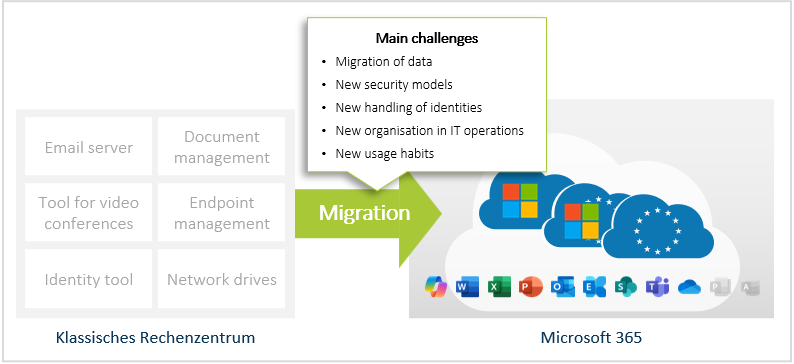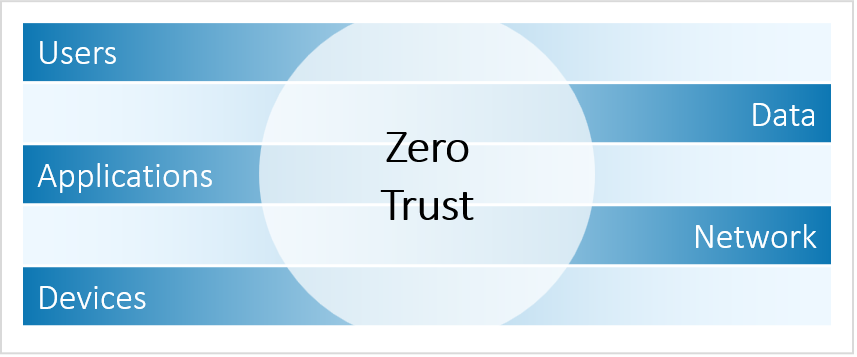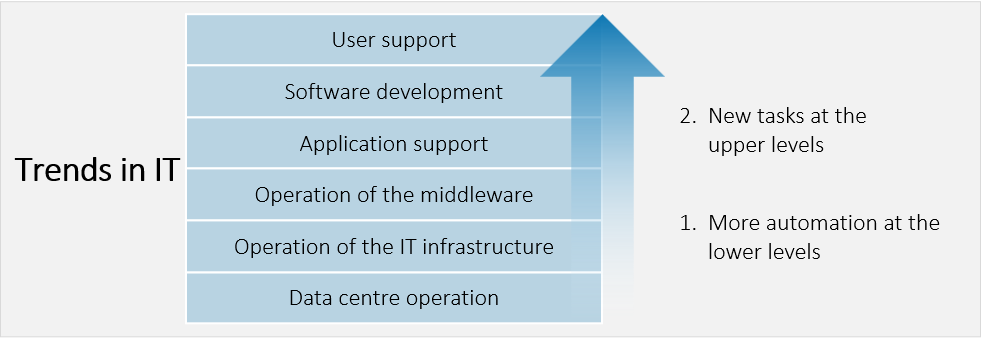
Introducing Microsoft 365 in the Public Sector
Stumbling blocks and best practices
Modernizing IT in the workplace is no simple undertaking. Such a project goes beyond simply changing the version of the Office package. In the public sector in particular, where the handling of sensitive data and high security standards are of the utmost importance, there are a number of challenges.
The public sector faces these challenges:
- Migration of the data: To use Microsoft 365 requires a smooth transfer to the cloud. This requires careful planning, backups and monitoring to ensure data integrity and security.
- New security models: Microsoft 365 can be used on many end devices worldwide. It should therefore be assumed that no network is trustworthy (zero trust). Each access attempt must therefore be individually authenticated and authorized.
- New handling of identities: As a rule, the switch to Microsoft 365 is also associated with the revision of identity management. In particular, this includes switching to multi-factor authentication and increasing ease of use through single sign-on.
- New organization in IT operations: With the introduction of Microsoft 365, many activities can be dispensed with as part of the IT in-house operation of the previous workplace IT. This changes the organization and division of tasks in IT operations.
- New usage habits: Microsoft 365 offers many new features as well as familiar functions, but in an unfamiliar look. Even if this results in extensive advantages for users, the large number of innovations means a change in their own habits.

In this blog article, we highlight common stumbling blocks and describe the most important best practices in transformation.
The Road to the Cloud Can Be Bumpy
Stumbling block 1: The introduction of a new IT workplace is seen as a pure IT project.
Intuitively, this is understandable at first; after all, an old technology is being replaced by a new one. However, this focused view quickly becomes a project risk, as the new workplace will only be accepted by employees if they have been involved in the process.

Similarly, the desired productivity gains will only be achieved if the organization and processes are adapted to the advantages of the new technology.
Stumbling block 2: The new IT workplace is introduced in full for everyone immediately.
The idea behind this is simple: the new generation of technology brings many advantages for users, the Microsoft 365 cloud could easily accommodate everyone at the same time and the migration would be completed quickly with a large project. However, the reality of large-scale IT projects is different: Planning takes exponentially longer, and a few influential doubters can cause major delays. Feedback from the field only reaches project management very late and costs increase due to the time-consuming coordination of the many parties involved. A staggered approach is therefore recommended: Pilot with open-minded users, incorporate practical experience into detailed concepts, communicate positive experiences widely and then migrate more and more user groups in stages.
Stumbling block 3: The concept work for identities and IT security is forgotten.
The switch from traditional IT to a cloud-based workplace is not a simple update. On the contrary, security paradigms in particular are changing: previously, an organization's files could only be accessed from within the company's network, often requiring special hardware and VPN access. With Microsoft 365, users can now access their documents from anywhere in the world via many different end devices.

To make this possible in the long term, secure identity management is required on the one hand and recurring authentication of users when accessing data (zero trust) on the other. The principles of both topics are very similar for all organizations, but the details can differ greatly. The necessary detailed concepts for this should be created individually for each organization in good time before the introduction of Microsoft 365.
Stumbling block 4: Forgetting the people in the project.
A core objective of the introduction of Microsoft 365 is to improve productivity in the IT workplace, i.e. to increase the ratio of economic output per hour worked. Not least for this reason, employees should be at the center of the introduction of Microsoft 365: How can technology help to improve the results of the work performed? How can artificial intelligence, for example, be used to achieve the same results in less time? These improvements will only take place if employees have been familiarized with the new tools in appropriate training sessions, are positive about the associated changes and are interested and curious about trying out the new functions.
Stumbling block 5: Waiting and hoping that the new technology was just hype after all.
Anyone who has been observing the world of IT for a while will have noticed that not everything that "comes to the table" in terms of new technologies has to be "eaten". The self-driving car, Bitcoin as an everyday currency, life in the metaverse: Many things have already been predicted that then got stuck on their way from vision to reality.

But one thing is certain: the cloud-based IT workplace is already a reality in society as a whole. It is the response to the hybrid working world, the diversity of end devices and the challenges of cyber security. It works on a large scale and will not pass us by.
Into the Cloud without Teething Troubles
Best Practice 1: Considering the introduction of Microsoft 365 as a key business project.
The new generation of the IT workplace helps all employees to achieve more with less effort. Collaborative work on the same document, easily switch between end devices without leaving the conference, access all files from anywhere and all devices, automatically summarize calls and compose emails. The list is almost endless. If the new workplace is introduced comprehensively and holistically, there are many advantages for the organization in many areas.
Best practice 2: Introducing Microsoft 365 in stages.
There are three truths behind this approach: Large IT projects fail more often than small ones, the proof of the pudding is in the eating and some users love innovations while others prefer to stick with the old. Our approach to introducing Microsoft 365 makes use of all three findings. After a brief assessment of the current situation in the customer organization, visions and goals are clarified, dependencies and risks are identified and the basic implementation decisions are made.

The introduction of the cloud-based IT workplace is piloted together with a user group that is open to innovations. The advantage: previously assumed dependencies and risks are validated and previously unknown ones are identified. This practical experience helps to make the introduction of Microsoft 365 smoother, especially for skeptical users. The introduction in stages also enables a smaller project team and reduces coordination efforts.
Best practice 3: Targeting productivity gains.
Productivity gains through the use of Microsoft 365 are possible in the following areas in particular: Due to the large number of highly integrated functions at the employee's workplace and the elimination of many activities in IT operations (e.g. the operation of server systems). However, these potentials can only be exploited if the usage behavior, work organization and processes of the company or public authority are also adapted to the specifics of the new technology.
For users, this primarily means taking part in training courses in order to understand the variety of new collaboration functions and use them to optimize day-to-day processes. For IT operations, on the other hand, it is about gradually shutting down legacy applications and training existing IT experts with regard to their new tasks in the cloud world.
Best practice 4: Change management and employee training.
Two trends have continued unabated since cloud technologies entered the world of information technology: At the lower levels of IT value creation (e.g. operation of IT infrastructure and middleware) there is more and more automation, and at the upper levels (e.g. no/low code development and user-related activities) there is more and more demand for IT experts.

Fortunately, both developments complement each other. Netflix, for example, operates its global IT infrastructure with several million daily users and a low double-digit number of employees. At the same time, there is a significant shortage of skilled software developers.
The introduction of Microsoft 365 frees IT employees from routine tasks and thus reduces their workload. Organizations should make targeted use of this potential, offer opportunities for further training and prepare the experts for the new tasks with more proximity to the users.
Best practice 5: Start now.
This advice is quickly explained: the use of cloud-based workplace IT brings many advantages for organizations and employees, and the "end-of-life" date for legacy applications is approaching. In addition, a secure and sustainable migration to Microsoft 365 requires a certain amount of time. Preparing now and exploring the world of cloud-based collaboration with a small group of interested parties makes sense in every respect.
Written by

Jörg Kähler can look back on 25 years of experience in Microsoft consulting. As Lead Solution Architect, he has been shaping the further development of Microsoft 365 for over ten years. He is responsible for modern managed workplace services that make working environments future-proof.



